When none of the evidence fits the official story, then that story must be wrong.
It was a quiet Sunday afternoon when I took my camera to the local town square for some urban archeology; to see if I could find clues to a mud flood, or any evidence of sunken architecture, any signs of a great deluge of earth or mud on the lower sections of the buildings in old Fayetteville Arkansas. I was not disappointed, yet I was not completely convinced that I was looking at real proof of a mud flood. I had to remain objective about what I saw.
There were definitely lots of entrances to shops around the square that were below ground level, and lots of lower windows that were cut off by the sidewalks, but were they all designed that way?
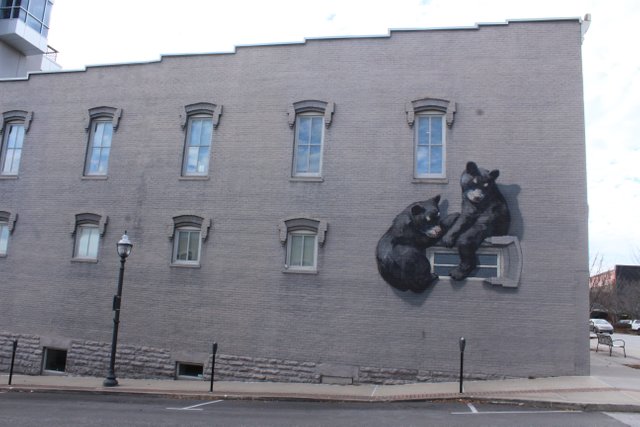
Searching For Evidence of a Past Mud Flood
My sudden interest in old architecture is based on the idea of a thing that's being called a 'mud flood', which is an apparent 'flood' of dirt which seems to have buried the lower sections of old 18th and 19th century buildings in cities on every continent on the planet. There seems to be virtually no mention of such a catastrophic thing during that time in our past from historians, but according to an accumulating amount of photographic evidence, these curious flows and piles of earth seems to have happened all around the world sometime during the early to mid 1800's.
We might have to take a minute to stretch our imaginations in order to accommodate such a notion, and it might be easier if we treat it as little mental game of logic and problem-solving. By such a game, an accurate version of our planet's history might emerge through the fog of any preconceived biases that may exist in our minds about the official tales of our past.
A Big Mental Experiment
To begin with, let us presume-- as a sort of mental experiment-- that every bit of history that we have been taught to believe has been a gigantic lie.
For the sake of experiment, suppose that every bit of our world history is just made up nonsense, passed down through previous generations who heard humanity's storyline from their parents as it was repeated by their grandparents who had heard the official version of the big lie about our planet's history from their school, or perhaps the church, and then retold again by the radio or the television.
Maybe the official stories of our planet's history give us comfort and seem true enough, and this mental experiment might be short-lived, dismissed as childish fantasy. Why try to re-write history now, and who are we to doubt the experts?
I myself was quite comfortable being bored with history, never thinking about it much. We're all forced to memorize parts of the story of our history, but then we grow up and forget most of those tales. I had forgotten nearly all of history, but it's when the expert's stories about that history don't match up with the evidence, that I begin to question the stories that I'm being told. Suddenly, I'm interested in architecture and local history.
Imagine a Global Catastrophe (or war) Happening Less Than 200 Years Ago
In the beginning of my own mental game with the mud flood idea as it was presented to me by Max Igan (@maxigan), I saw quite a few old photos that were interesting and compelling, but I still wasn't sure. A planetary deluge of biblical proportions which happened less than 200 years ago? Definitely hard to believe at first, but the game I had started with myself got a lot more interesting when I saw another video* on Utube titled 'Mud Flood Cincinnati - A Juicy bit of Evidence' posted by the youtuber exheliocentric.
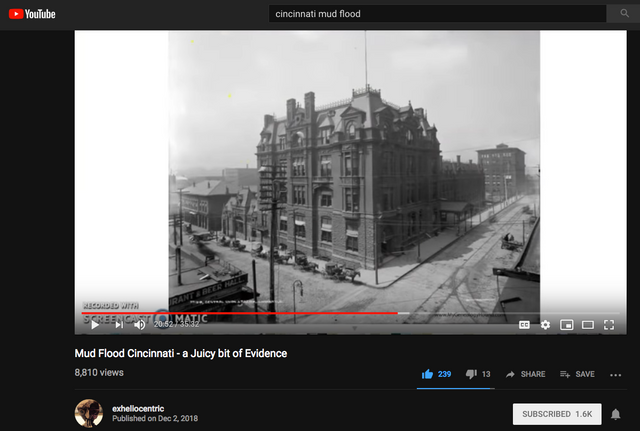
Direct Evidence of a Mud Flood in Cincinnati USA?
It seems that exheliocentric, the creator of the video, has discovered something amazing. He found an old photo (above) of a building from the 1800's taken in Cincinnati, Ohio, showing a structure which has since been demolished. The photo's description gave the address of the old building, and exheliocentric heroically went to Cincinnati and took some photos of what was left of the building in that location. (video link at the bottom of this page)
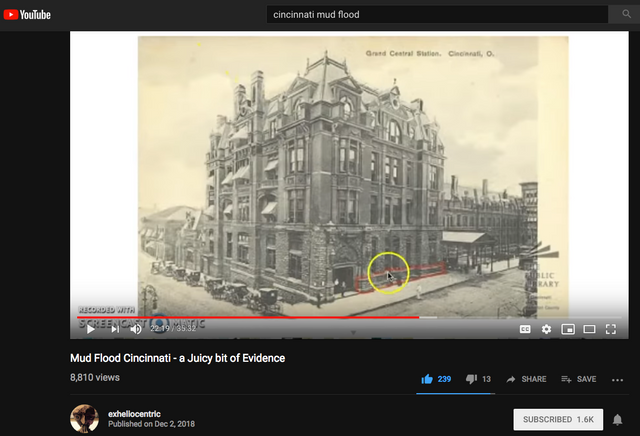
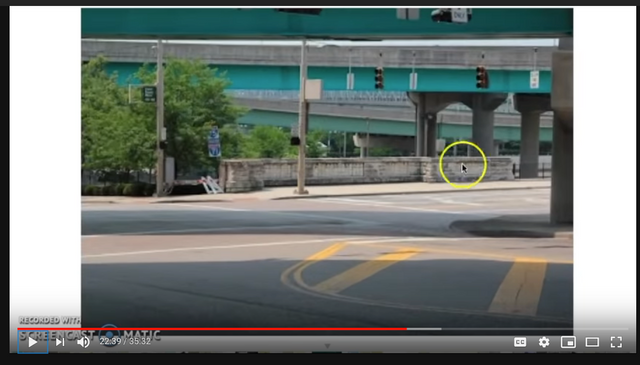
From street level, the original structural wall can still be seen, while the old building is long gone, replaced now by a lower parking lot area. Finally, from that parking area 10 or 12 feet below, exheliocentric took photos of the old inside wall that remains there below the road:
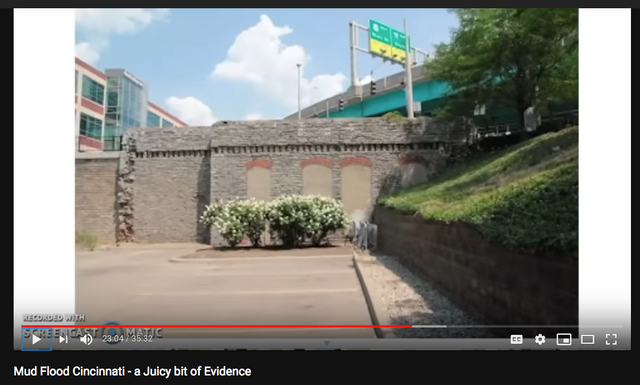
These images, seen all together, raise a certain question or two. If the old photo was in fact taken during the 1800's back when the building was supposedly built, then why are there windows and a door built into that lower part of the old wall, way below street level, as shown in exheliocentric's photos? Which came first, the wall of dirt, or the wall of the building? If the dirt came later, it looks like the building's owners just decided to put a new main entrance into the second floor instead of trying to excavate around the lower parts of the structure.
Earthquake?
If a wall of earth came along after the building was constructed, then we might think of a great deluge, a flood so gigantic that it left an embankment against this old building. Another thing that might have caused such movement of earth would be a large earthquake, and liquefaction of soil-- shaking the earth into a liquid form-- will sink heavy buildings as the vibrations toss the ground around them. During strong earthquakes, dirt and sand can 'boil' up upon itself through the muddy mess into big piles while the tremors last, piles of dirt and mud spilling out across the streets, even burying smaller structures completely as they sink in the vibrating sea of soil. This only brings up more questions though: why haven't we heard all about such a destructive earthquake happening in a major US city in the 1800's?
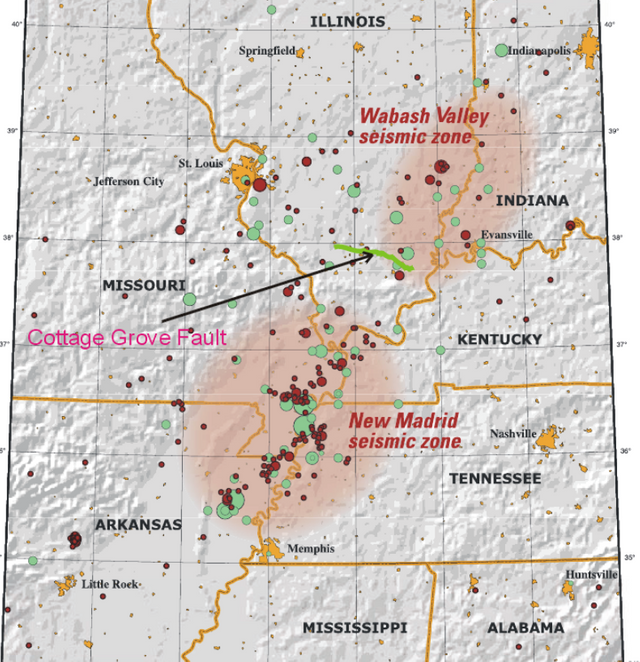
Maybe these major North American seismic fault zones have been more faulty that we've been told.
There was apparently a few major earthquake in North America back in 1811 and 1812, called the New Madrid Earthquakes, and today we are told that the epicenter of these quakes was around the southeastern corner of Missouri and the upper East parts of Arkansas. Legends are told of entire towns being swallowed as the earth was liquified during the greatest tremors, and the vibrations in the water of the rivers caused ripples of waves that made the water appear to run upstream, and "the mighty Mississippi River ran backwards" has become one of the more well-shared factoids about that earthquake, along with "church bells rang in Boston". We are told that there were few people living in the New Madrid area at that point in time, but what do they mean when they say 'people'?
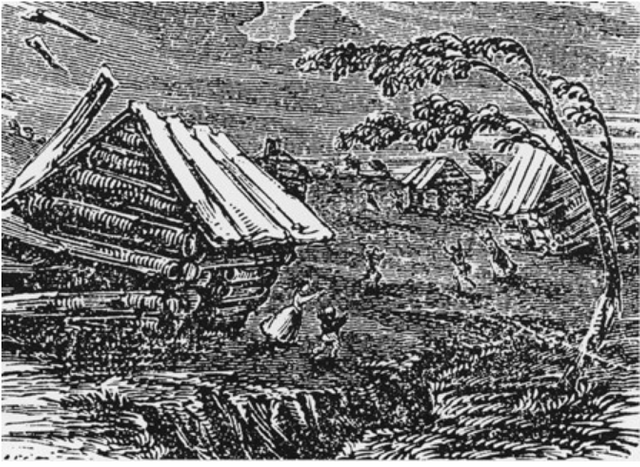
Taking it To the Streets
After seeing so much evidence, I was well caught up in the game of stories and puzzles. With no sure history of the planet to refer to, I showed up to the scene heavily armed with a wild and teeming imagination, and I imagined a worldwide civilization that might even have existed here in Arkansas before any European settlers showed up erecting log cabins around the ruins of great cities. Then, I imagined and supposed what if the little town of Fayetteville was abandoned by a previous civilization, only to be 'discovered' later by some guy named Lafayette or whatever, a little ready-built town in the hills just waiting to be dug out of the dirt and cleaned up a little bit before the new pioneers came along to stake their claims on the sturdy buildings that they found.
These strange, haunting stories dashed through my head as I walked around the empty square with my camera, and while I still couldn't decide if the architecture was buried on purpose by the designers of the old buildings along the square, there were enough submerged windows and entries on those older buildings to make me keep wondering and imagining.
What if it was a weapon of some sort that had liquified the earth in these areas? That would help to explain why we never heard about it.
A Few Pictures
Instead of thinking that I knew one thing or another about what I was seeing, I just walked around and took a few shots of the odd submerged entrances and windows that were used on so many of the shops around the lonely Sunday Fayetteville square that day. Was this little town mud flooded? I don't know!
Curiously High Sidewalks and Weird Low Doorways of Fayetteville's Square
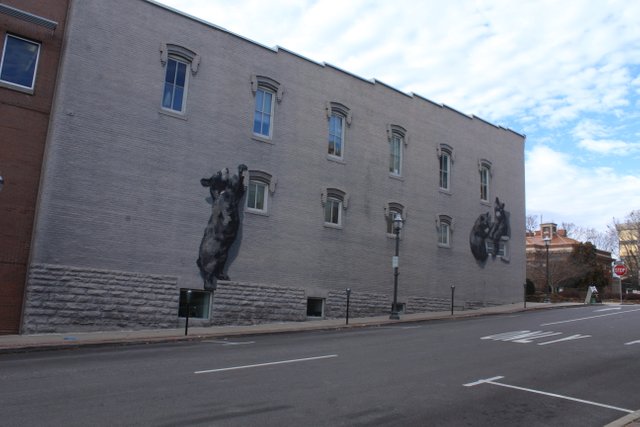
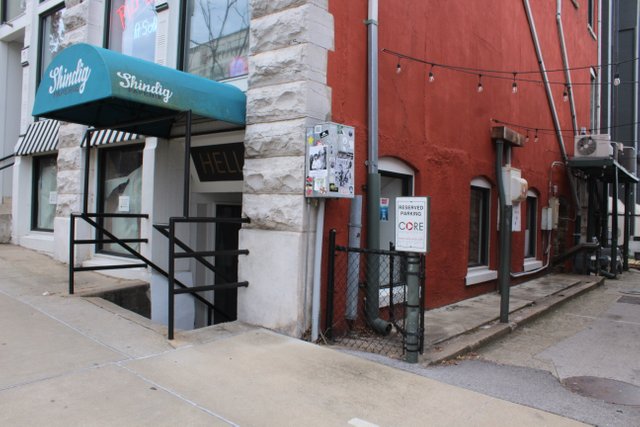
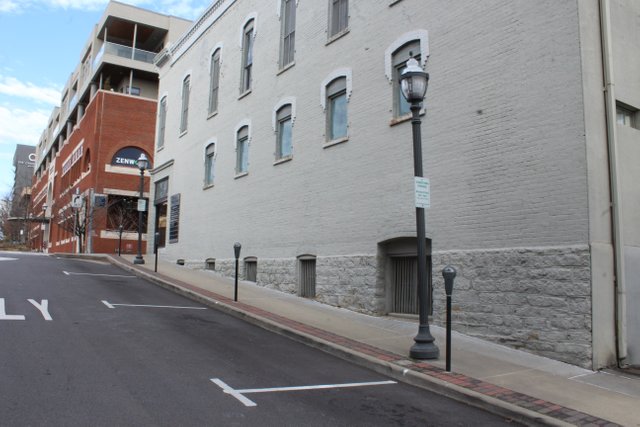
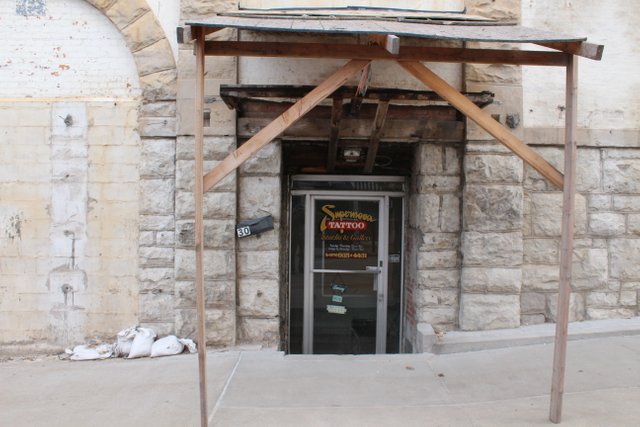

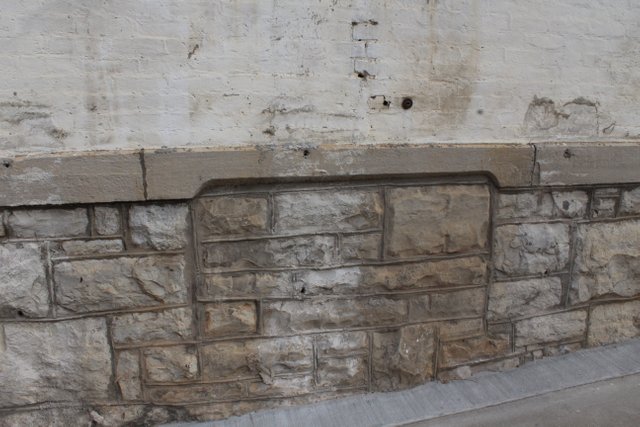


There was a plaque in the middle of the square, but now I'm not sure if any of the words upon the plaque are based on truth, or if this plaque is simply reciting the local script and cover story. Everything must be examined and questioned in this ongoing mental experiment.

Since we seem to be left to write history based on the evidence that we have before us in buried bricks and stone all around the world, then we might have to make some major changes in the official story of Earth's history. If we can objectively observe the evidence and data that surrounds us without the usual limitations of things like religious or academic acceptance, and if we can put aside the old culturally-accepted stories of our past, we might see a whole new version of things. Now that the mud flood has hit the internet, this new urban archeology could begin to solve some of history's greatest puzzles.
It's just a mental experiment though, and nobody is obligated to change their perceptions of the world based on a few old photos, or to easily change their idea of history even in the face of acute physical evidence and countless geological anomalies all around the planet.
It's just too much to take in all at once, but now that I can recognize that old style of architecture, I see the buried lower windows and I immediately imagine a great civilization that apparently lost a great war or was reduced to fragments following a planetary cataclysm of some kind, their lives, technology and wisdom all lost and buried under the mud. To think that it could have happened during the 1800's is especially freaky, since most of the old buildings around this area are attributed to that time period, and I can examine them and the landscape around them with my own senses and eyes.
How such recent catastrophic events could have been erased from history so thoroughly, that is another puzzle game for another time.
*Below is the Cincinnati mud flood video by exheliocentric on Utube that was referenced above:
Previously on the 'mud flood' topic:
https://steemit.com/blog/@therealpaul/search-for-a-massive-mud-flood-in-the-past-coming-soon-to-a-little-town-near-you
Photos of Fayetteville architecture above are mine, 2019, while earthquake images are provided by Wikimedia Commons.

ǝɹǝɥ sɐʍ ɹoʇɐɹnƆ pɐW ǝɥ┴
Downvoting a post can decrease pending rewards and make it less visible. Common reasons:
Submit
The trouble is that we didn't pass on the history from parent to children.
For these last hundred years, we have sent children off to minimum security prisons where they were forced to learn, in the worst way possible, factoids about a history that never actually existed.
Lincoln and the Cherry tree? Never happened.
Pilgrims and Thanksgiving? Never happened.
George Washington was a great visionary leader? Well, he was good at running away, which actually led to winning of the revolutionary war. By the way, did you read about the Whisky Rebellion? Where GW attacked and killed americans?
Tartarus, ask the Ukrainians and they remember the capital. But, look it up in a history book, and there is nothing.
And then you have the fact that anyone who tries to match up the dark ages writing with the phases of the moon, find that it is an impossible task. Most who have looked seriously into it find that there is 100 to 1000 years missing.
So, yes, everything in our govern-cement school history books is false.
Downvoting a post can decrease pending rewards and make it less visible. Common reasons:
Submit
I thought it was Washington who didn't cut down the cherry tree, but I must have missed my indoctrination that day when they 'taught' that story.
It is a trip that many old maps show Tartary as the largest country on the planet, yet as you said, history books prefer to ignore that huge civilization for some reason.
It's becoming increasingly easier to dismiss the 'Dark Ages' as a made-up period of history that possibly never happened-- a lot of our chronology makes more sense when that 1000 years is removed from the story.
Downvoting a post can decrease pending rewards and make it less visible. Common reasons:
Submit
I find these things fascinating and love old architecture. It does make you wonder why these things weren't spoken of and passed down through the generations. A window or doorway to nowhere surely would have raised questions. I guess public buildings wouldn't have been left in a family, though, too pass it on.
This raised quite a conversion with hubby on how much history is rewritten.
Posted using Partiko Android
Downvoting a post can decrease pending rewards and make it less visible. Common reasons:
Submit
I'm happy to have inspired some alternative thoughts about history, that Utube video really got my attention too when I saw those mysterious window frames and that door 10 feet under the sidewalk.
Downvoting a post can decrease pending rewards and make it less visible. Common reasons:
Submit
Congratulations! Your post has been selected as a daily Steemit truffle! It is listed on rank 11 of all contributions awarded today. You can find the TOP DAILY TRUFFLE PICKS HERE.
I upvoted your contribution because to my mind your post is at least 4 SBD worth and should receive 260 votes. It's now up to the lovely Steemit community to make this come true.
I am
TrufflePig, an Artificial Intelligence Bot that helps minnows and content curators using Machine Learning. If you are curious how I select content, you can find an explanation here!Have a nice day and sincerely yours,

TrufflePigDownvoting a post can decrease pending rewards and make it less visible. Common reasons:
Submit
Good story. In Europe, lots of older buildings had basements with windows at or below ground level. In Vancouver, Canada, we have tunnels under the streets where steam was supplied to multiple buildings from a central boiler. Those doors and windows that had been blocked up in your photographs could have been openings to a tunnel. The explanations and possibilities might be endless.
Downvoting a post can decrease pending rewards and make it less visible. Common reasons:
Submit
I did consider the possibility that the subterranean door and windows could have led to an underground room or tunnel. That idea, by itself, leads to a whole other world of intrigue, and almost makes more sense than a forgotten mud flood.
Downvoting a post can decrease pending rewards and make it less visible. Common reasons:
Submit
Hello @therealpaul, thank you for sharing this creative work! We just stopped by to say that you've been upvoted by the @creativecrypto magazine. The Creative Crypto is all about art on the blockchain and learning from creatives like you. Looking forward to crossing paths again soon. Steem on!
Downvoting a post can decrease pending rewards and make it less visible. Common reasons:
Submit